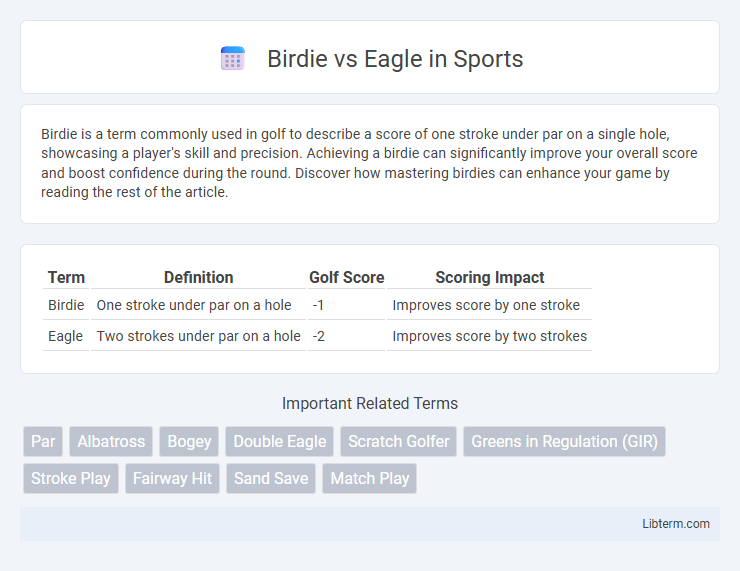Birdie is a term commonly used in golf to describe a score of one stroke under par on a single hole, showcasing a player's skill and precision. Achieving a birdie can significantly improve your overall score and boost confidence during the round. Discover how mastering birdies can enhance your game by reading the rest of the article.
Table of Comparison
| Term | Definition | Golf Score | Scoring Impact |
|---|---|---|---|
| Birdie | One stroke under par on a hole | -1 | Improves score by one stroke |
| Eagle | Two strokes under par on a hole | -2 | Improves score by two strokes |
Birdie vs Eagle: Golf Scoring Explained
In golf scoring, a birdie represents completing a hole one stroke under par, while an eagle means finishing two strokes under par. Birdies are more common and reflect a player's strong performance on individual holes, whereas eagles signify exceptional skill or advantageous course conditions. Understanding the difference between birdie and eagle is crucial for tracking progress and evaluating a player's competitive edge in the game.
Understanding the Birdie in Golf
A birdie in golf signifies completing a hole one stroke under par, showcasing a player's precision and skill. Achieving a birdie often boosts a golfer's confidence and can significantly impact the overall score in competitive play. Unlike an eagle, which is two strokes under par, a birdie remains a common yet impressive milestone that reflects consistent performance on the course.
What is an Eagle in Golf?
An eagle in golf refers to a score of two strokes under par on a single hole, showcasing exceptional skill and precision. For example, scoring a 3 on a par-5 hole or a 2 on a par-4 hole constitutes an eagle. Achieving an eagle is rarer and more impressive than a birdie, which is one stroke under par.
Key Differences Between Birdie and Eagle
A birdie, commonly known as a birdie or birdie score, occurs when a golfer completes a hole one stroke under par, while an eagle signifies finishing a hole two strokes under par. Birdies are more frequent and signify solid performance, whereas eagles are rarer, reflecting exceptional skill or favorable conditions. The key difference lies in the stroke count relative to par, with eagles offering a higher achievement and significant impact on a golfer's total score.
How to Achieve a Birdie
Achieving a birdie in golf requires completing a hole one stroke under par, which demands precise shot execution and effective course management. Focus on accurate tee shots to set up shorter approach shots, allowing for easier chances at hitting the green close to the pin. Consistent putting skills and mental focus are crucial for converting those opportunities into a successful birdie score.
Tips for Scoring an Eagle
To score an eagle in golf, focus on accurate shot placement and distance control, typically requiring completing a hole in two strokes under par, such as a two on a par-4 or a three on a par-5. Prioritize powerful drives and precise approach shots, targeting the green with minimal strokes to set up a makeable putt. Practice reading greens carefully and mastering long putts to capitalize on eagle opportunities effectively.
Birdie vs Eagle: Impact on Your Golf Scorecard
A birdie, scoring one stroke under par on a hole, significantly boosts your golf scorecard by demonstrating precision and skill, often lowering your total score. An eagle, scoring two strokes under par, has an even greater impact, dramatically improving your round and increasing the potential for a winning score. Understanding the difference between birdie and eagle helps golfers strategize scoring opportunities and assess performance effectively.
Famous Birdies and Eagles in Golf History
Birdies and eagles represent significant achievements in golf, with birdies scoring one stroke under par and eagles two strokes under. Legendary golfers like Tiger Woods are famous for their numerous birdies, while players such as Arnold Palmer and Jack Nicklaus are renowned for their impressive eagles that turned critical holes during major championships. These scoring feats have cemented their places in golf history, showcasing skill and strategic play on iconic courses.
Strategies to Improve Birdie and Eagle Chances
Improving birdie and eagle chances on the golf course involves enhancing precision and distance control through consistent practice and course management. Utilizing advanced shot-tracking technology and analyzing swing mechanics can refine accuracy, enabling better approach shots and putting performance. Incorporating strategic risk-reward decisions, such as targeting favorable pin positions and selecting appropriate clubs, increases scoring opportunities for birdies and eagles.
Birdie vs Eagle: Which Is More Impressive?
Birdies and eagles both represent scoring feats in golf, but an eagle, achieved by completing a hole two strokes under par, is generally more impressive than a birdie, which is one stroke under par. Eagles require exceptional skill and precision, often involving long putts or reaching the green in fewer strokes on par-5 holes. The rarity and difficulty of eagles elevate their status, making them a more remarkable achievement compared to birdies in the sport.
Birdie Infographic

 libterm.com
libterm.com